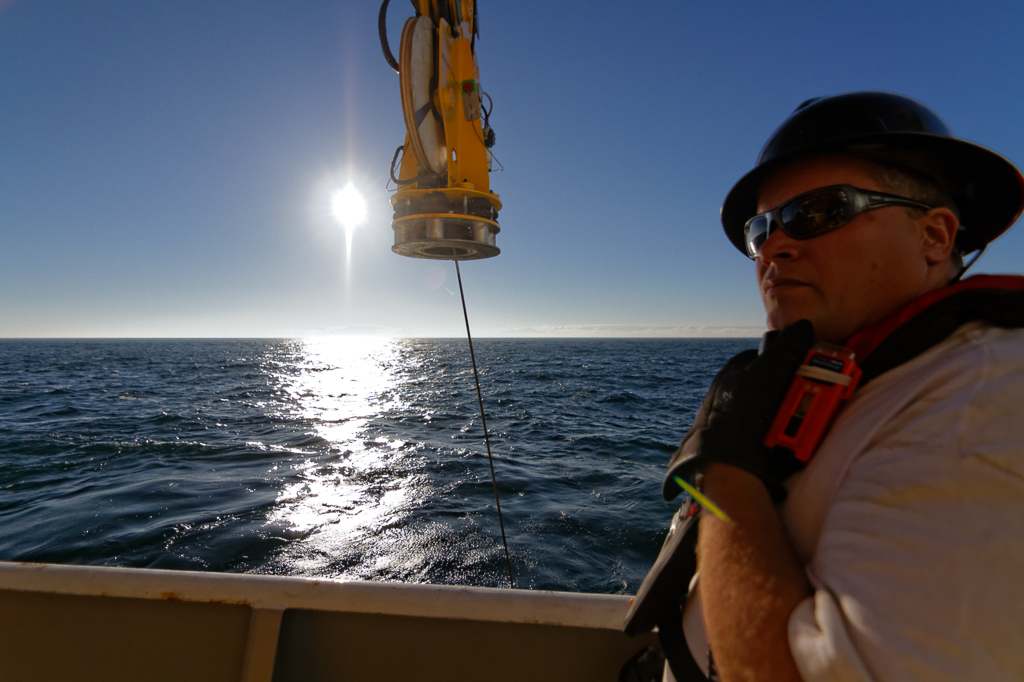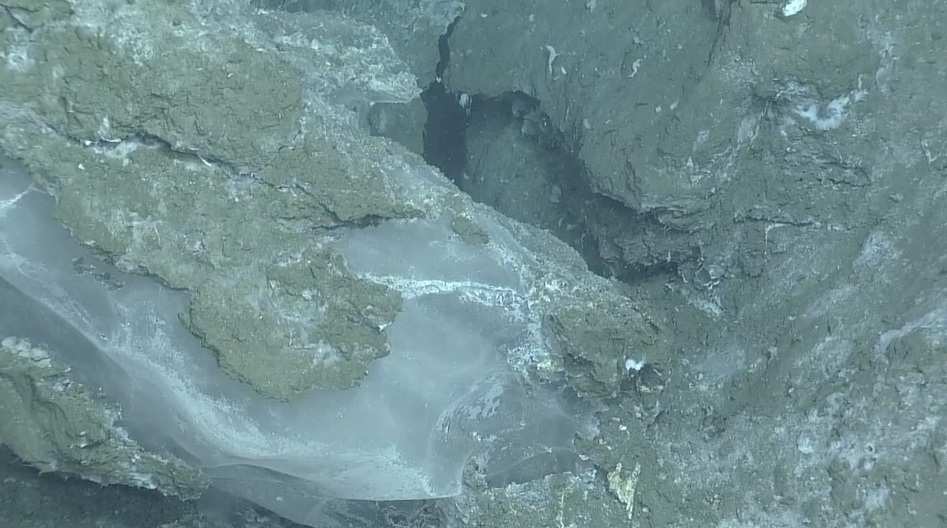Image Archive





























The Axial Base vertical mooring EOM cable terminates approximately 10m above the anchor (left) in a "strongback" (right)-- a cage designed to protect the EOM cable termination and provide a strong mechanical link to the mooring. The strongback is connected to the anchor via a pair of acoustic releases, a 31" syntatic foam float and short lengths of chain. The anchor slid into place approximately 100m from the secondary node, causing some nervous moments as that distance was at the limit of the cable reach. Credit: OOI-RSN/UW/CSSF

The UW-APL mooring team (l-r) Keith Magness, Avery Snyder, Paul Aguilar and Eric Boget ready the 200m platform and EOM strongback cage for deployment at the Axial Base site. Credit: Mitch Elend

Photo Credit: Hannah Delapp, University of Washington, V14

Photo credit: Hannah Delapp, University of Washington, V14

Knot Making 201, Monkey Fist Knot Photo Credit: Jae Jose, University of Washington V14

Photo Credit: Skip Denny, APL, V14

Photo Credit: Trevor Harrison, University of Washington, V14

Skip Denney provided the students of Leg 5 a tour of the fantail which included a detailed explanation of all of the parts to the vertical moorings and a descriptrion of the equipment utilized in the deployment of it. Photo Credit: Colin Katagiri, University of Washington, V14

Equipment on the back deck Photo Credit: Hannah Delapp, University of Washington, V14

Credt: Hannah Delapp

Heading under the Newport Bridge Photo Credit: Hannah Delapp, University of Washington, V14

The VISIONS '14 Leg 4 Science, Engineering, and ROPOS team gather on the R/V Thompson for a group photo at the end of Leg 4. Photo Credit: Mitch Elend, University of Washington, V14.

Keith Tamburri led all ROPOS operations during Leg 4 of the VISIONS'14 Expedition. He is the Assistant Manager for the Canadian Scientific Submersible Facility. During Leg 4, he directed 30 ROPOS dives. Image Credit: Ed McNichol, V14.

A before and after image of the fantail on the R/V Thompson the day we left port (August 26) and came back (September 10). In between these two port calls, we came back into Newport and loaded another complete set of gear to install on the seafloor. Photo Credit: Mitch Elend, University of Washington, V14.

Lauren relaxes during a sunny day on the R/V Thompson, Leg 4, VISIONS'14. Photo Credit: Ed McNichol, Mumbian Enterprises, Inc. V14

Myesa Legendre-Fixx on the R/V Thompson on Leg 4 of the VISIONS'14 Expedition. Photo Credit: Ed McNichol, University of Washington, V14

Sunset at the end of Leg 4. Photo Credit: Kevin Simans. Image Credit: Kevin Simans, University of Washington, V14.

The VISIONS'14 team was presented a gift near the end of Leg 4 - a beautiful sunrise. Photo Credit: Billy Medwedeff, Umiversity of Washington, V14.

r1784_highlights

The ROV ROPOS samples jets of methane bubbles with a hand-held Niskin bottle. Photo credit: NSF-OOI/UW/CSSF; Dive R1784; V14.

The manipulator arm of the ROV ROPOS reaches for a small block of methane hydrate wedged against a small rampart and nearly vertical wall within a large collapsed area at the summit of Southern Hydrate Ridge. Several minutes after sampling this site with the ROV, a continuous jet of methane bubbles issued from the large opening to the right of the hydrate sample. The methane hydrate is translucent, very clean and is reminscent of quartz with a conchoidal-like fracture pattern and is partially encased in a thin skin of sediment. Credit: UW/NSF-OOI/CSSF; ROPOS Dive R1784; V14.

ROPOS holds a small piece of translucent methane hydrate - upon release by the manipulator jaws, the methane-ice floated upwards into the water column, confirming to all viewers, that indeed it was methane hydrate. Photo credit: NSF-OOI/UW/CSSF; Dive R1748; V14.

r1781_highlightsnode

screenshot2014-09-07at7.15.08pm_med

screenshot2014-09-07at8.24.39pm_med

Mola mola, a sunfish, are the heaviest known bony fish. They can weigh ~2000 lbs - they mainly eat jellyfish. Credit: Billy Medwedeff, University of Washington; V14.

A large lingcod hangs out around a Primary Node PN1C on the cabled observatory. Credit: UW/NSF-OOI/CSSF; ROPOS Dive R1789; V14.

Soft corals dot the rough carbonate surfaces of the ~ 60 m-tall limestone monolith west of the active seeps at Southern Hydrate Ridge. Credit: UW/NSF-OOI/CSSF; ROPOS Dive R1779; V14.
- Anemone
- Animal
- Arthropod
- ASHES
- Axial
- Axial Base
- Axial Biology
- Axial Caldera
- Bacteria
- Basalt Lava
- BEP
- Biofouling
- biolgoy
- Biology
- Camds
- Camera
- Camhd
- Central Caldera
- Ciliates
- Cnidaria
- Coastal Biology
- Crab
- Deep Profiler Mooring
- Dive Highlights
- Eastern Caldera
- Echinoderms
- Endurance Array
- Engineering Team
- ENLIGHTEN 10
- Exploratorium
- Fish
- Geology
- HD Camera
- HPIES
- Hydrate Ridge
- Hydrates
- Hydrophone
- Hydrothermal Vents
- Illustration
- Inshore 80 Meters
- Instrument
- International District
- J-BOX
- Jason
- Jellyfish
- Junction Box
- K12
- Lava
- Mollusk
- Moorings
- Nodes
- Nudibranch
- Octopus
- OOI
- Oregon Offshore
- Oregon Offshore 600 m
- Oregon Shelf
- Oregon Slope Base
- People
- PN1B
- PN1D
- Polychaetes
- PPSDN
- Primary Node
- RASFL
- ROCLS
- ROPOS
- ROPOS Dives
- ROV Team
- RV Revelle
- RV Sikuliaq
- RV Thompson
- Salp
- Sample
- SC13
- Science Team
- Sea Cucumber
- Sea Star
- Sea Urchin
- Seafloor
- Seismometer
- Sensors
- Shallow Profiler Mooring
- Shark
- Shipboard
- Shore Station
- Slope Base
- Smoker
- Soft Coral
- Southern Hydrate Ridge
- Sponge
- Squid
- Students
- Students & Guest Participants
- Tmpsf
- Tubeworms
- VISIONS 11 Leg 1
- VISIONS 11 Leg 2
- VISIONS 11 Viewers
- VISIONS 13
- VISIONS 14
- VISIONS 15
- VISIONS 16
- VISIONS 17
- VISIONS 18
- VISIONS 20
- VISIONS 22
- VISIONS 23
- Visualization
